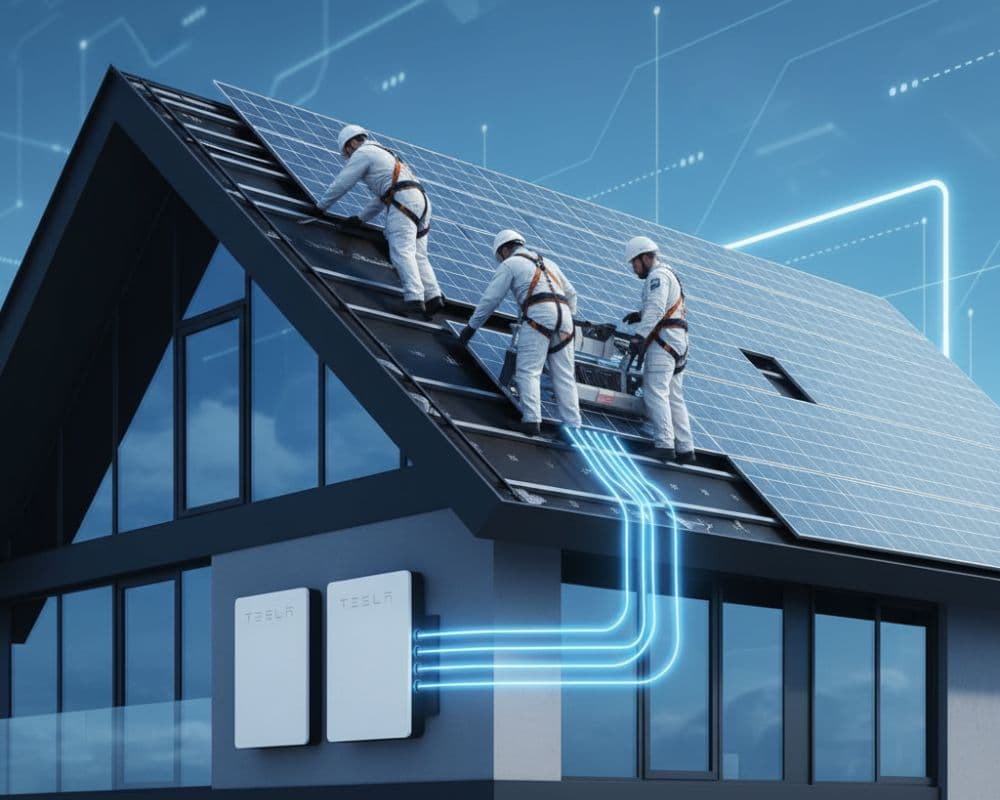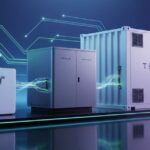A home that makes its own clean energy and saves it for later is real now. The Tesla Solar Roof and Powerwall make this possible because they work together perfectly. The system is more than just solar panels and a battery. It is a smart, complete home energy system. It gives people energy independence, lowers their power bills, and provides dependable backup power.
A truly self-powered home needs two things. It needs a way to make electricity and a way to save it. The Tesla Solar Roof makes the power. It takes the place of your old roof with nice, strong solar tiles. The Tesla Powerwall saves the power. It works as your home’s smart battery. When people put these two parts together, they make a closed system. The system manages your energy by itself and does it well. This combined method makes Tesla different. It turns your home into its own small power company.
The article will explore how the Tesla Solar Roof and Powerwall Integration works, the key benefits offered, and the real-world experience of owning the cutting-edge home energy solution.
How Tesla Integrates Solar and Storage System
The Tesla system is beautiful because its design is simple, and its operation is smooth. Engineers made every part work together. A single, easy-to-use app manages the whole system.
The Tesla Solar Roof: Power in Plain Sight
The Tesla Solar Roof is a new product because it takes the place of normal roof materials with glass tiles that make solar power. The Solar Roof is the roof itself. It is not like big, old solar panels placed on top of a roof you already have.
1. Aesthetics
The textured glass tiles look like regular roof materials when seen from the street. They offer a smooth, simple look that many homeowners like.
2. Durability
The strong, tempered glass is very tough. It often has a longer warranty than normal roof materials.
3. Functionality
Some tiles make solar power, and others do not. Tesla can change the system to fit your home’s power needs and the shape of your roof.
The design makes sure your home’s power making is an important, nice-looking part of the building.
The Powerwall: Your Home’s Energy Brain
The Powerwall is Tesla’s battery for your house. The Powerwall is the smart center of the whole system. It holds the extra energy your Solar Roof makes during the day. You can use the stored energy at night or when the power goes out.
The newest one, the Powerwall 3, has a main new feature: a solar inverter built right in. This part helps the Tesla Solar Roof and Powerwall work better together. The direct current (DC) power from the solar roof changes to alternating current (AC) power for your house inside the Powerwall box. The integrated inverter makes the installation easier. It helps the system work better. It uses fewer parts on your wall.
1. Self-Consumption
Powerwall lets you use your own solar power all day and night. It helps you get the most value from the energy you make.
2, Backup Power
Powerwall gives you power right away and without stopping when the main power grid fails.
3. Time-of-Use (TOU) Optimization
Powerwall can charge itself when power costs are low. It can use the stored power when rates are high. This saves you money.
The Integration Advantage: Why They Work Better Together
The real strength of the Tesla Solar Roof and Powerwall working together is that the system is closed-loop. The parts of the system talk to each other all the time. They manage your energy flow, so you do not have to do anything.
Quote: Elon Musk has said that Tesla solar products will only be sold with the Powerwall. He wants to make sure people have a smooth experience.
Starting next week, Tesla will sell Solar Panels and a Solar Roof only with a Powerwall product. Powerwall is a fundamental part of having a clean energy future.
The promise to put the parts together makes the system work best for your home. The system helps you save money, use the solar power you make, or get ready for a storm.
Benefits of Tesla Solar Roof and Powerwall Integration
Homeowners who buy the integrated Tesla system get big benefits. The benefits are more than just making electricity.
Energy Independence and Self-Consumption
The main good thing about Powerwall is that you can stop needing the electric company as much. The Powerwall saves your extra solar energy. Because of this, you do not have to buy costly electricity from the company at night.
- Daytime: Your home runs directly on solar power from the Solar Roof.
- Evening/Night: Your home runs on the stored energy in the Powerwall.
- Peak Hours: The Powerwall can discharge to avoid using expensive grid power during peak rate times.
Using your own saved power is often the best way to save money with solar energy. It works well where rules about selling extra power back to the company are not very good.
Reliable Backup Power During Outages
The best reason people like the Tesla Solar Roof and Powerwall together is the peace and comfort of having reliable backup power. When the main power grid stops working, the Powerwall starts up by itself. It gives power to the important parts of your house.
The system is designed to power your home seamlessly. You won’t even notice the grid went down. The Powerwall’s capacity (13.5 kWh per unit) is enough to power critical loads like lights, refrigerators, and Wi-Fi for several days, especially when the Solar Roof is simultaneously recharging the battery during the day.
Financial Savings and Incentives
The first cost is high, but the combined system saves a lot of money over a long time.
| Financial Benefit | Description | How the Integrated System Helps |
|---|---|---|
| Federal Tax Credit | Homeowners can claim up to 30% of the total system cost as a federal tax credit under the Inflation Reduction Act. | Both the Solar Roof and Powerwall qualify for the credit, lowering your upfront investment significantly. |
| Time-of-Use (TOU) Savings | Electricity rates rise during peak hours (4 PM – 9 PM) when demand is high. | The Powerwall discharges stored energy during these hours, helping you avoid expensive grid electricity. |
| Reduced Utility Bills | Using more of your own solar energy means buying less from the grid. | The Solar Roof generates and the Powerwall stores clean energy, maximizing self-consumption and cutting monthly bills. |
| Increased Home Value | Homes with solar + battery systems attract buyers and often sell at a premium. | The sleek Solar Roof design and integrated Powerwall boost both aesthetics and property value. |
Real-World Tesla Solar Roof and Powerwall Experience
The journey to owning a self-powered home involves understanding installation and cost facts.
Tesla Solar Roof Installation Process
Installing the Tesla Solar Roof and Powerwall is a complicated building job. Workers must remove the old roof. They install the new solar tiles. They set up the electrical parts, including the Powerwall and the gateway. The gateway manages the connection to the electric company’s grid.

The time it takes can change a lot, but here is what you can usually expect:
- Permitting and Design: Getting permission and final plans takes the longest time. This part needs approval from the local power company and the city.
- Roof Removal and Installation: Workers physically install the new roof and tiles.
- Electrical Setup: Workers install the Powerwall, the inverter, and the gateway.
- Commissioning and Inspection: Tesla and local inspectors do final checks before turning the system on.
Tesla has tried to make the process quicker. Homeowners should get ready for a project that lasts many weeks, especially for the Solar Roof part.
Tesla Solar Roof and Powerwall Cost Analysis
The Tesla Solar Roof and Powerwall Integration is a very good product and costs a lot of money. It usually costs more than putting up regular solar panels and a battery system separately. The cost changes based on how big your roof is, how much electricity you need, and how many Powerwalls you must have.
However, many homeowners find the investment worthwhile due to:
- Aesthetics: The superior look of the Solar Roof is a major factor.
- Durability: The 25-year tile warranty and the long-term energy production guarantee.
- Integration: The seamless, single-app management and optimized performance of the integrated system.
Case Study
A real-world example demonstrates the value of this integration. Consider a homeowner in California who installed a 10kW Solar Roof and two Powerwalls.
The Experience: The electric company started planned power cuts during a recent heatwave that lasted many days.
The Performance: The connected system automatically shut off from the main power lines. The system kept running power to the house. The Solar Roof made enough power in the daytime. It ran the air conditioner and filled the Powerwalls again. The stored power kept the refrigerator and important lights working at night.
The Outcome: The homeowner did not lose power at all. Meanwhile, neighbors lost electricity for hours. The experience shows the main value of the system: it can handle problems and provide safe energy.
Practical Tips for Tesla Solar Roof Owners
If you are considering the Tesla Solar Roof and Powerwall Integration, here is some practical advice to ensure you get the most out of your system.

1. Choosing the Right System Size
Sizing your system correctly is the most important decision. You must match your solar production to your home’s energy use and your backup needs.
- Review Your Bills: Look at your utility bills from the last 12 months. Find your average daily and yearly energy use. Use the unit kWh.
- Solar Roof Sizing: Tesla’s design team will use your energy data. They will also use satellite pictures of your roof. They will decide the size of the Solar Roof needed to meet your energy needs. Use the unit kW.
- Powerwall Sizing: Your backup needs decide the number of Powerwalls you need. One Powerwall holds 13.5 kWh of energy. One Powerwall is often enough for important things like lights and a refrigerator. You may need two or more Powerwalls. Use more Powerwalls for whole-house backup or to have power for many days without sun.
2. Maximizing Solar Roof and Powerwall Efficiency
The Tesla app is your main tool for making things work best after installation.
- Set Your Operation Mode: You choose your mode. You can pick “Self-Powered” to use the most solar power. You can pick “Backup Only” to keep the battery full for power cuts. Or, you can pick “Time-Based Control” to save money based on electric company prices.
- Monitor Production and Consumption: You must check the app often. You see how much power your Solar Roof makes. You also see how much power your home uses. Knowing this helps you find appliances that use a lot of energy.
- Adjust Backup Reserve: In places with bad weather, you must raise your Powerwall’s backup reserve. Doing so ensures you have enough power saved for a long power cut.
Conclusion
The Tesla Solar Roof and Powerwall turn any home into a smart energy system. Together, they make clean power, store it safely, and use it when needed. This setup helps you save money, keeps the lights on during blackouts, and gives you more control over your energy. Though the cost is higher at first, the long-term savings, strong design, and energy freedom make it worth it. With Tesla’s technology, your home doesn’t just use power — it makes its own future.
FAQS
How long does the Powerwall last during a power outage?
The duration depends on the number of Powerwalls you have and your home’s energy consumption during the outage. A single Powerwall (13.5 kWh) can typically power essential loads for 1-3 days. If the Solar Roof is generating power, it can recharge the Powerwall, extending the backup duration indefinitely.
Is the Tesla Solar Roof more expensive than traditional solar panels?
Yes, the initial cost of the Tesla Solar Roof is generally higher than a traditional solar panel installation of the same capacity. However, the Solar Roof replaces your existing roof, so the comparison should include the cost of a new traditional roof plus solar panels. The aesthetic appeal and integrated design are also factored into the premium.
Can I get the Solar Roof without the Powerwall?
Tesla’s current policy, as stated by Elon Musk, is to sell the Solar Roof and solar panels as an integrated product with the Powerwall. This is because the Powerwall is considered a fundamental component for energy management, efficiency, and backup power.
What is the warranty on the Tesla Solar Roof?
The Tesla Solar Roof comes with three warranties: a 25-year tile warranty, a 25-year power generation warranty, and a 10-year Powerwall warranty. This comprehensive coverage provides long-term peace of mind for the entire system.







